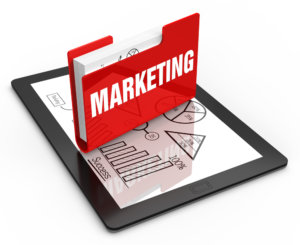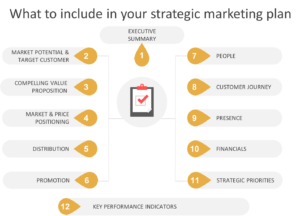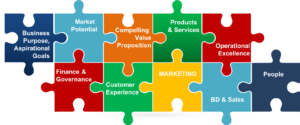
The power of a well thought through and executed strategic marketing plan can have a profound impact on your growth ambitions. It’s overarching goal is to identify your target market and customers, understand how to reach and engage in a way that suits them, and in doing so, turn them from a potential customer into a raving fan. Your marketing strategy is one of the most important strategies you will ever develop, and it’s worth taking the time to get it right.
One of the easiest things in the world today is to find a book, a website, or a blog about marketing. Which is why I’m NOT going to talk endlessly about marketing theory, strategies, techniques or tactics here.
You see, most entrepreneurs, business owners and leaders get caught with the ‘shiny object syndrome’ (SOS). The shiny object syndrome is simply getting distracted by endless new ideas, developments or innovations without truly understanding whether it’s right for their business or their customers or whether it’s the right time to implement. Anything new or ‘sparkly’ catches their eye and before you know it they or their team are researching, investigating and implementing it.
So what I want to do is give you some practical ideas to help you write your strategic marketing plan. A single document that combines all of your marketing goals and priorities with the strategic objectives of your business so if, or when, you are overcome with ‘SOS’ you can refer back to your strategic marketing plan and say ‘thank you, but no thank you. I don’t want to take my business down the wrong path’.
What to include in your strategic marketing plan
You’ve probably heard the principle of spending an hour to save five minutes (those five minutes being saved over and over again, forever, thanks to the hour long investment you have made), and that’s precisely the point of a structured strategic marketing plan.
Don’t allow ideas to live in your head, or to be the basis of informal, or even formal discussions. A strategic marketing plan is your comprehensive document or blueprint that details the current market position of your business, your target market, a description of the marketing mix you’ll use to achieve your marketing goals and most importantly, how you’ll measure whether it’s working or not.

Section 1: Executive Summary
This is the last section you’ll write as it summarises everything included in your plan. It should be short and succinct. Your executive summary should allow the reader to easily grasp the fundamentals of what you are trying to achieve and instantly make the decision as to whether they want to read more.
Section 2: Market Potential & Target Customer
Defining your market potential will identify the overall market size, the total revenue opportunity for your product or service, and your target customer. When looking at market size and opportunity it’s important to quantify how many customers are willing to pay for your products or services and who those customers are. A baseline estimate is better than no estimate at all. Without knowing your market size you may be conducting business in a market so small, it’s next to impossible to make any money. This section should validate your target market can deliver sustained and profitable business growth, making your marketing efforts viable and realistic.

Not sure how to define your market potential and target customer? Check out these 13 questions here
Section 3: Compelling Value Proposition
Document how you differentiate your products and services, and what you believe is your competitive edge. Most likely if a business doesn’t have or can’t develop competitive advantages they won’t survive. Know your business; your strengths, weakness, threats and opportunities (SWOT analysis) and know the same of your competitors.
Create a baseline of precisely where you’re at with the maturity of your current product & service offering as this will give you the platform to systematically and strategically enhance and develop your value proposition. Knowing your ultimate goal is to become truly market leading.

Not sure how to map out your CVP? Read 5 steps to building a compelling value proposition.
Section 4: Market & Price Positioning
Market and price positioning is a highly complex area: get it right and sales and profit flow; get it wrong one way and sales flow, but profit is poor; the other way and sales are poor, but profit per transaction is good. Any market and price positioning should be based on informed, decision making aligned to your long-term strategic goals.
A good book to check out is ‘Blue Ocean Strategy’ which focuses on how to create new market space, and in doing so, you make the competition irrelevant. Consider your market position; differentiated, undifferentiated, low end or high-end and identify your white space opportunity.
Detail how you set or adjust your prices including any promotional pricing you may implement (discounts, product bundling etc.) across your various product lines and most importantly, the rational for this (end of product line, up-sell or cross sell opportunity).
Section 5: Distribution (Place)
Your distribution channel – your route to market – should make it easy for your customers to buy what you are offering, in the way they want to buy it, at the time they want to and are ready to consume it. Include your current channels to market and your plans or aspirations to consider new ones i.e. e-commerce / online.
Section 6: Promotion
Naturally this section should be the largest section in your strategic marketing plan. It will detail how you are going to ‘promote’ your products and services (section 3), to your target audience (section 2), with your agreed pricing strategy (section 4) and channels to market (section 5).

Your promotional activity will probably be multi-faceted, a mix of online (digital) and/or offline activities, taking into consideration your target audience and your product and service offering. Taking your overarching marketing strategic priorities (section 12) outline the initiatives you intend to implement in order to achieve that particular goal. This will detail amongst other things the initiative (i.e. advertising), channel (i.e. social – Facebook), timeframes (6 week campaign).
It is this section of your strategic marketing plan which you can lift and transfer into a more tactical marketing plan detailing your key milestones, action owners, budget allocation and deadlines per initiative. This is a great sense check because if you find you are working on tasks which are not in your marketing plan then you can bet they are not in your strategic marketing plan. If that’s the case, stop and sense check why you are doing them (are you suffering from SOS?). Ask yourself ‘will this help me achieve my business growth goals?’
Section 7: People
All companies are reliant on their people from front line Sales staff to the Managing Director. Having the right people is essential because they are as much a part of your business offering as the products or services you are offering.
Outline any people developmental gaps you may have identified or are aware of. For example, are you proposing an advertising campaign for a product which will require a refresher of knowledge. Or are you planning a brand awareness campaign and you want to ensure all your people are ‘on brand’ with key messages. Include it. If you’re responsible for people development as well as marketing, great, you’ve started outlining your people plan. If you’re not, you’ve just demonstrated you can think outside of marketing.
Section 8: Processes (Customer Journey)
The delivery of all products and services need to be underpinned by clearly defined and efficient processes. Customer journey maps are extremely useful as they will help you map your end to end customer interactions, from prospect to sale to long-term relationship, identifying those moments where you add real value to your customers and those which don’t.

Your customer journey links directly to your customer experience. Check out 4 components of the customer experience you should know.
Section 9: Presence (Physical Evidence)
Physical evidence is what attracts your customers first – they will judge your service or product after looking at your physical evidence. Customers tend to rely on physical cues to help them evaluate the product before they buy it or before they buy it again! The role of the marketer is to design and implement such tangible evidence; your website, packaging, materials, store or ‘shop front’, invoices, email templates, newsletters etc.
This ‘physical evidence’ is the proprietary channels and customer touch-points you control. Businesses are missing opportunities every day to maximise their engagement, marketing messages, brand building and sales through these touch-points which they already own and have genuine legitimacy to communicate through.
List all your proprietary channels and how you are maximising their effectiveness.
Section 11: Financials
In financials include a three-year line of sight: target financial goals, revenue and profitability for years 3, 2 and 1. Plus the business growth aspirations to give context to the numbers. For example, plans to enter a new market, or merger, or new proposition launch. The numbers and background context should be easily available / extracted from the business’s strategic plan.

Haven’t got a strategic plan? Check out Strategic Plan: what to include in yours.
Section 12: Marketing & Communications Key Strategic Priorities
Documenting your key strategic priorities will keep you focused on what you want to achieve and not become distracted by SOS (there it is again!). Create 4-5 strategic objectives to keep you laser beam focused as opposed to having 10-15 which all start to merge into one over time. Examples areas include; brand awareness, lead generation, customer engagement and nurturing, online presence, thought leadership, new product launch.
Your strategic marketing priorities should naturally come off the back of your business growth plans. If they don’t, then question whether they are in alignment.
Section 13: Marketing & Communications Key Performance Indicators/Metrics
Your KPI’s are an imperative element of your strategic marketing plan. If you don’t know what’s working how do you know what to change or improve? There are a number of KPI’s that should be on your radar but the most important thing to remember is that you need to be able to measure them. There is no point building a complex dashboard of metrics if you haven’t the means to measure the results. Identify the KPI’s you absolutely need and want to track and then ensure you have the tools in place to measure the outcomes.
KPI’s to consider…
Sales growth derived from marketing effort (actual ROI per activity)
Leads & opportunities created
Website traffic – unique visitors, impressions, landing page conversions
Social media reach & engagement
Email marketing performance
Tracking your marketing KPI’s will help validate everything you do and provide you with transparency in your marketing efforts.
Why writing your strategic marketing plan is like completing a jigsaw puzzle

The interdependencies between marketing and the other nine business growth enablers is so tightly woven that the boundaries where one stops and another one starts can often become blurred, especially when you focus in on market potential, customer experience and products & services.
It is important to recognise this because, in your business, if you own and manage all these areas you can easily find the interdependencies and work to make them stronger. If on the other hand, you’re part of a wider organisation with stand-alone functions, there is a real risk insights and lessons won’t be shared unless you take action to ensure they are.
This is where your strategic marketing plan comes in. It will bring the different elements into one place, into your strategic marketing plan. One view of the world. One version of the truth.
Want to know how your strategic marketing plan shapes up?
Marketing has the power to take an otherwise unknown entity (a brand, product or service) and launch it into the global marketplace like nothing else can.
Take The Business Growth Pathway test and assess the power in your marketing and communications. You never know you may surprise yourself.
Simply answer questions on your marketing & communications and receive an in-depth, personalised report on what is working, what is not & what you need to do differently.
And the good news. Everyone has a free trial. So take the test today for free.


